After watching your prized petunias wilt in the scorching afternoon sun, you’ll want to rethink your garden’s sunny spots with plants that actually thrive in intense heat. While many gardeners struggle with full-sun locations, you’ve got plenty of resilient options that won’t just survive but flourish in those challenging conditions. Let’s explore which sun-loving plants can transform that harsh exposure into your garden’s most impressive feature.
Contents
- 1 Drought-Tolerant Lavender Thrives
- 2 Colorful Heat-Loving Black-Eyed Susans
- 3 Drought-Hardy Purple Coneflower Blooms
- 4 Tough Yarrow Shows Vibrant Colors
- 5 Hardy Butterfly Bush Attracts
- 6 Lantana Blooms Summer-Long
- 7 Heat-Loving Drought-Proof Sedum
- 8 Blazing Star’s Purple Spikes
- 9 Sun-Loving Russian Sage
- 10 Drought-Resistant Verbena Spreads Wide
Drought-Tolerant Lavender Thrives
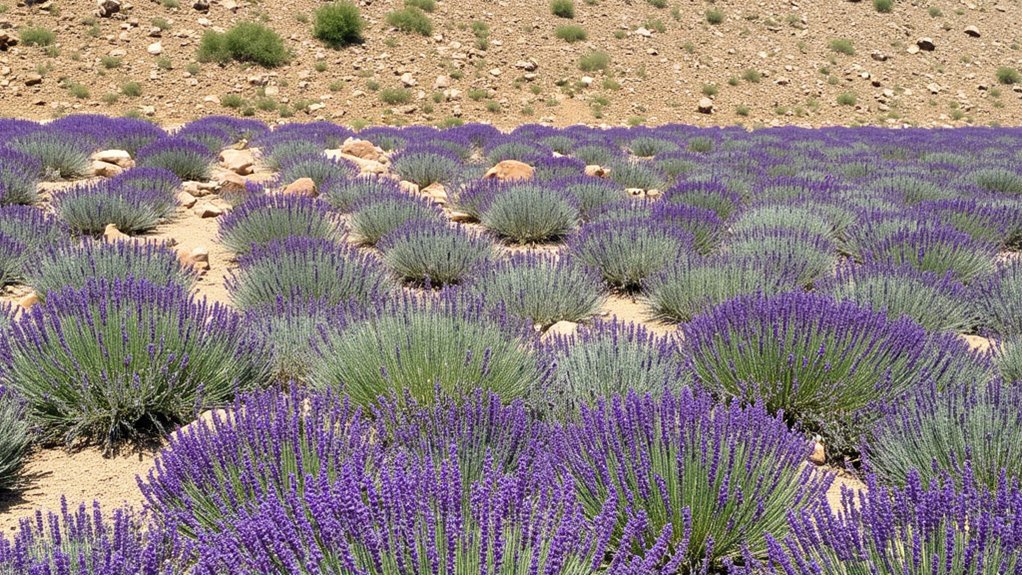
While many plants struggle in intense sunlight, drought-tolerant lavender positively thrives in hot, dry conditions. You’ll find this Mediterranean native doesn’t need coddling – it actually performs better with minimal watering and full exposure to scorching rays.
Plant your lavender in well-draining soil, spacing plants 18-24 inches apart to guarantee proper air circulation. You’ll want to position them where they’ll receive at least 6-8 hours of direct sun daily, and don’t worry about intense afternoon heat.
Water deeply but infrequently, about once every 7-10 days during the first growing season. After that, you can reduce watering to every 2-3 weeks. If you’re dealing with clay soil, mix in plenty of sand or gravel to improve drainage – lavender’s roots won’t tolerate wet feet.
Colorful Heat-Loving Black-Eyed Susans
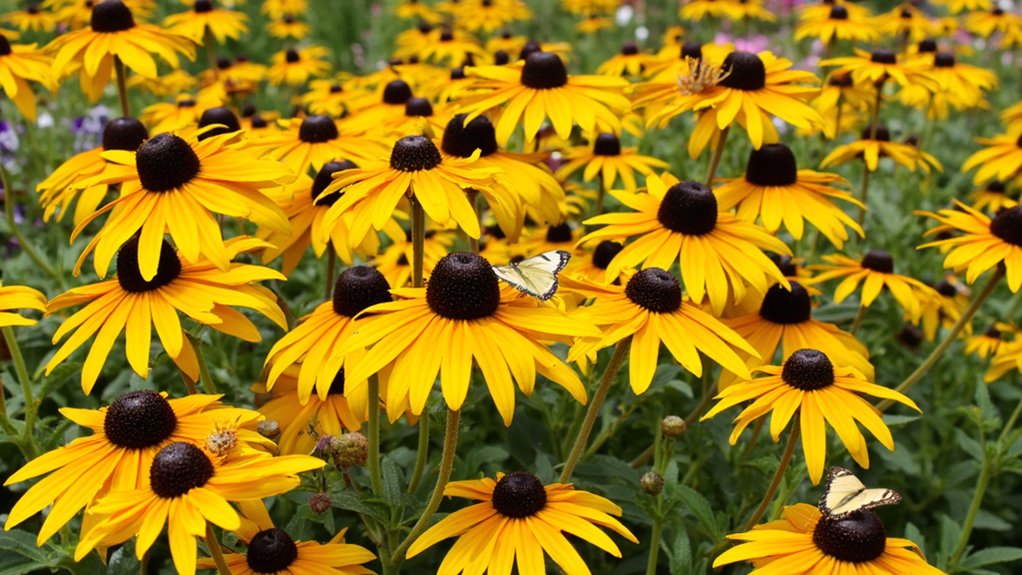
Black-eyed Susans stand as cheerful sentinels in the summer garden, soaking up intense sun that would wilt lesser plants. These hardy perennials, reaching heights of 2-3 feet, will bloom consistently from July through October if you deadhead spent flowers regularly.
You’ll find these native wildflowers incredibly easy to grow, as they’ll thrive in almost any well-draining soil without frequent watering. Space plants 18 inches apart when planting, and you’ll soon see them spread naturally through self-seeding. Their golden-yellow petals surrounding dark brown centers attract butterflies and provide excellent cut flowers.
For the best results, divide your Black-eyed Susan clumps every 3-4 years in early spring. They’ll reward you with masses of blooms that can withstand temperatures well above 90°F without dropping petals or losing vigor.
Drought-Hardy Purple Coneflower Blooms
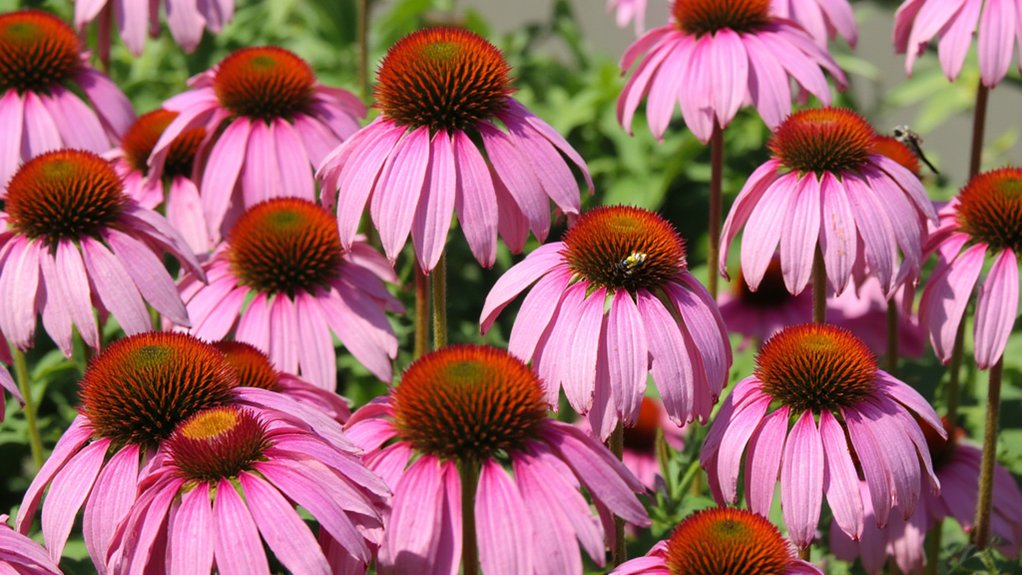
Similar to their sunny-natured cousins, Purple Coneflowers bring striking drama to hot, sunny spots with their bold purple-pink petals and prominent copper centers. You’ll find these sturdy perennials thrive in zones 3-9, reaching heights of 2-4 feet with a spread of 18-24 inches.
Plant your coneflowers in well-draining soil 18-24 inches apart, and they’ll reward you with blooms from June through October. Once established, they’ll tolerate drought conditions and only need watering when the soil is completely dry 2 inches deep.
These low-maintenance beauties attract butterflies and make excellent cut flowers, lasting 5-7 days in arrangements. For continuous blooming, deadhead spent flowers regularly, though you might want to leave some seedheads standing – they’ll feed birds through winter and self-seed readily.
Tough Yarrow Shows Vibrant Colors
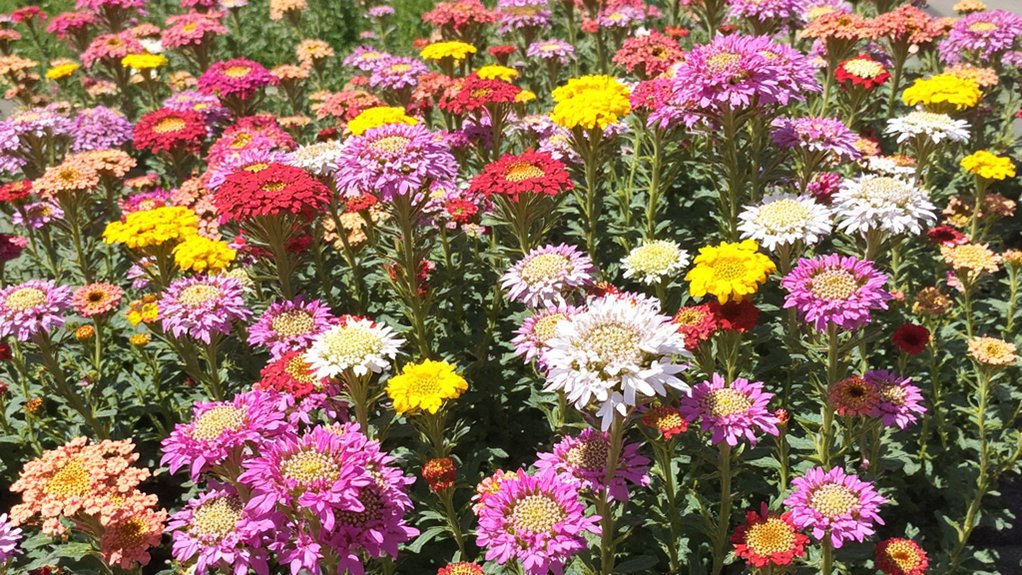
Among the most resilient sun-lovers you’ll find in any garden, Yarrow offers an explosion of flat-topped flower clusters in shades of yellow, pink, red, and white throughout summer. You’ll love how this hardy perennial grows 2-4 feet tall and spreads readily, making it perfect for filling tough spots where other plants struggle.
Plant your yarrow in well-draining soil and space them 1-2 feet apart, as they’ll quickly form dense clumps. You won’t need to water much once they’re established, and they’ll thrive in poor soil conditions where other plants fail.
For the best blooms, cut back the stems by half after the first flush of flowers fades. This practice, known as deadheading, encourages a second round of blooming and prevents unwanted self-seeding in your garden.
Hardy Butterfly Bush Attracts
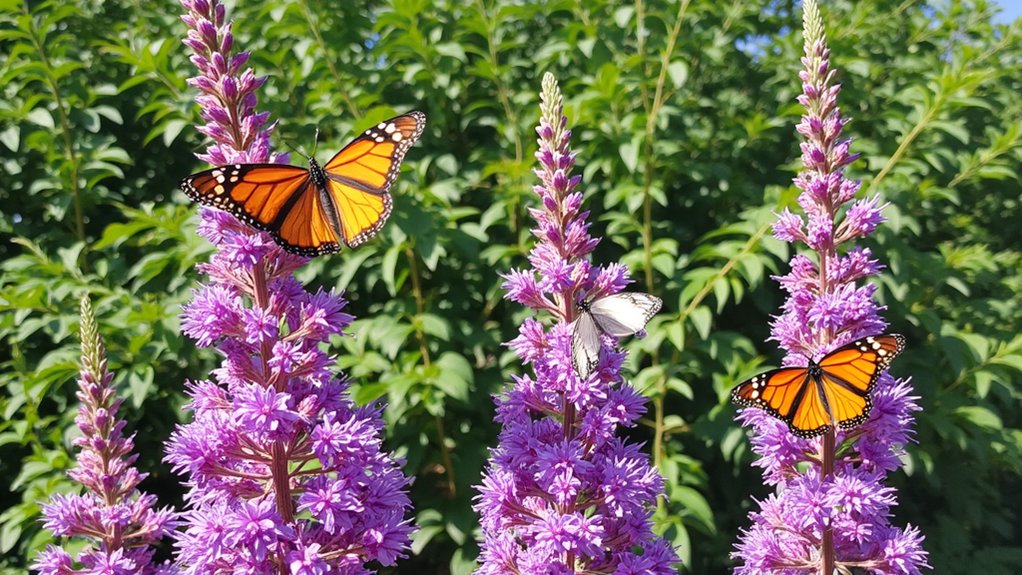
The dramatic butterfly bush stands as a magnet for pollinators, drawing butterflies, hummingbirds, and bees to your sun-drenched garden spaces. You’ll find these hardy shrubs thriving in zones 5-10, where they’ll reach heights of 6-12 feet with proper care and maintenance.
Plant your butterfly bush in well-draining soil during spring or fall, spacing plants 5-6 feet apart. You’ll need to prune it back to 12 inches above ground in early spring, as the bush blooms on new growth.
For the best flowering display, deadhead spent blooms regularly and provide deep watering once weekly. You can choose from varieties featuring purple, pink, white, or blue flower spikes that bloom from summer through first frost, ensuring months of pollinator activity in your garden.
Lantana Blooms Summer-Long
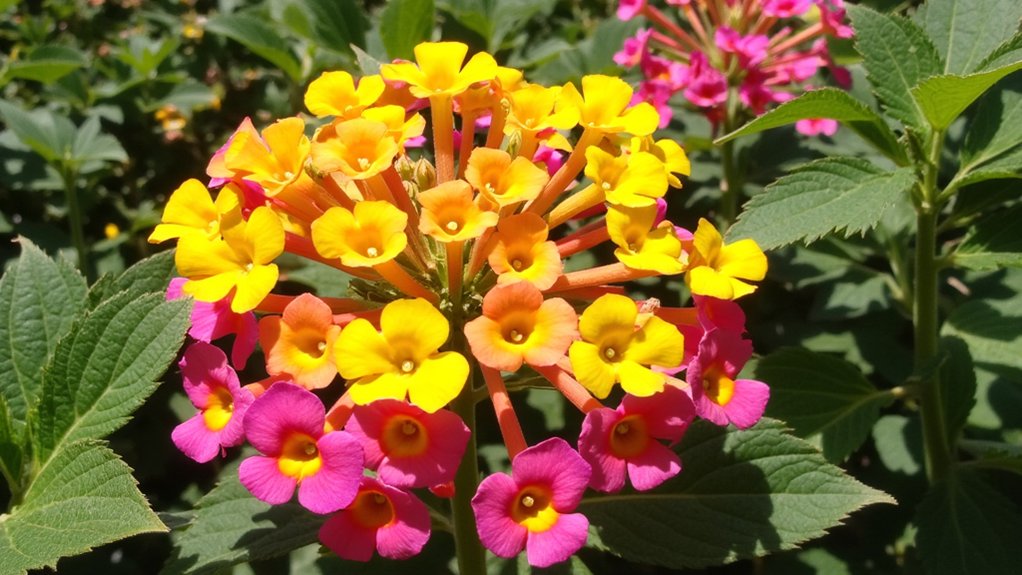
While many sun-loving plants wilt in intense summer heat, lantana thrives and produces clusters of vibrant blooms in yellow, orange, pink, red, or multi-colored combinations. You’ll find this drought-tolerant perennial reaches heights of 2-6 feet, spreading up to 4 feet wide in zones 8-11.
Plant your lantana in well-draining soil 2-3 feet apart, and you won’t need to water it more than once a week once established. It’s perfect for containers, borders, or as a flowering ground cover in areas that receive 6+ hours of direct sunlight daily.
For continuous blooming from late spring through first frost, deadhead spent flowers and trim back leggy growth by one-third. You’ll notice butterflies, hummingbirds, and bees can’t resist lantana’s nectar-rich flowers, though deer tend to avoid it.
Heat-Loving Drought-Proof Sedum

Succulent sedum varieties offer exceptional heat tolerance and drought resistance, making them ideal choices for scorching sunny spots. You’ll find these hardy plants thriving in temperatures up to 90°F, while requiring only monthly watering during peak summer months.
Plant your sedum 12-18 inches apart in well-draining soil, positioning them where they’ll receive 6-8 hours of direct sunlight daily. Most varieties grow 4-24 inches tall, with spreading habits that can cover 24 inches in diameter.
You’ll appreciate sedum’s color-changing display throughout the growing season. The fleshy leaves start blue-green in spring, while fall brings rich burgundy and copper tones. The clusters of tiny flowers, appearing in late summer, attract butterflies and persist through first frost, providing multi-season interest in your drought-tolerant garden.
Blazing Star’s Purple Spikes
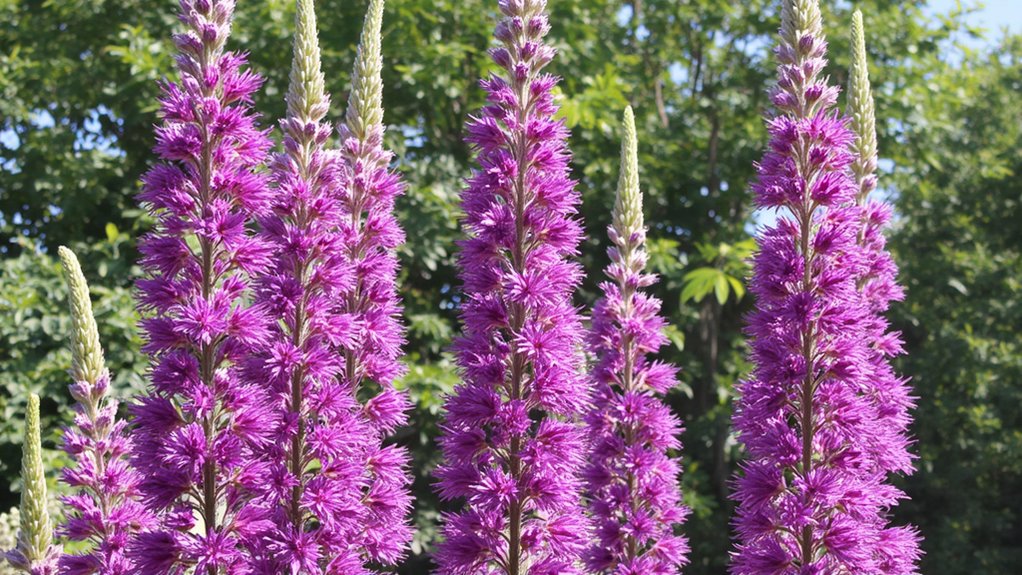
Native to North American prairies, Blazing Star (Liatris spicata) produces dramatic purple flower spikes that tower 2-4 feet high in full sun gardens. You’ll want to plant these upright perennials 12-15 inches apart in well-draining soil, where they’ll bloom from July through September.
Once established, you won’t need to fuss over your Blazing Stars – they’re incredibly drought-tolerant and can handle temperatures well above 90°F. Their dense flower spikes attract butterflies and hummingbirds, while deer tend to leave them alone. For the best display, plant them in groups of three or five.
Cut the spikes back to ground level in late fall, and you’ll see new growth emerge in spring. They’ll multiply gradually through their corms, giving you more plants to share or relocate.
Sun-Loving Russian Sage
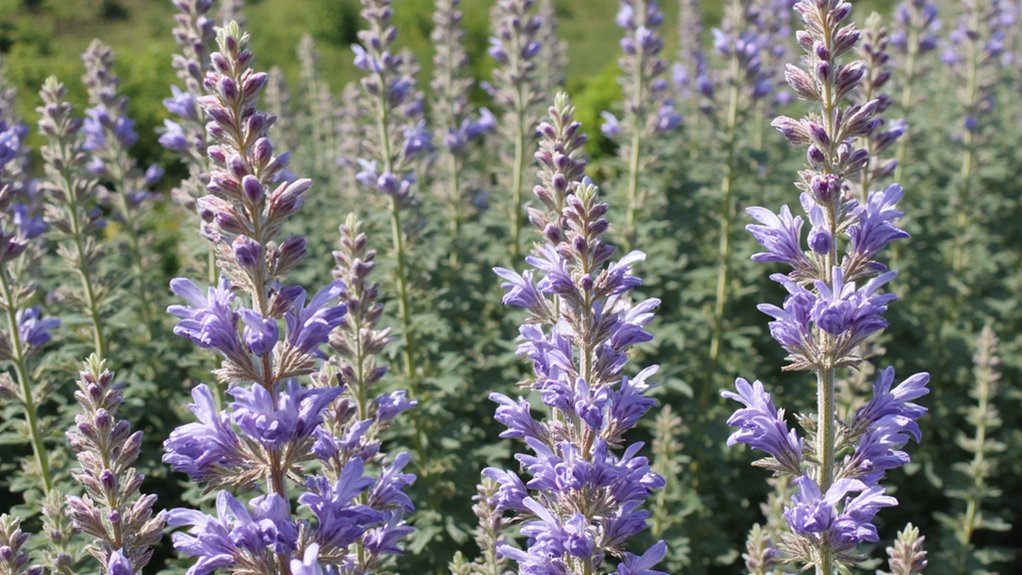
Despite its common name, Russian sage (Perovskia atriplicifolia) isn’t a true sage at all, but rather a hardy perennial that’ll thrive in the hottest, driest spots of your garden.
You’ll love this plant’s silvery-gray foliage and lavender-blue flower spikes, which reach heights of 3-5 feet and spread 2-4 feet wide. The aromatic leaves and long-lasting blooms attract pollinators from July through October.
Plant your Russian sage in well-draining soil and space them 24 inches apart. Once established, they’re incredibly drought-tolerant and need minimal care. You’ll want to cut back the stems to about 6 inches in early spring to encourage bushy growth.
For the best flowering display, place these sun-lovers where they’ll receive at least 6 hours of direct sunlight daily. They make excellent companions for ornamental grasses and coneflowers.
Drought-Resistant Verbena Spreads Wide
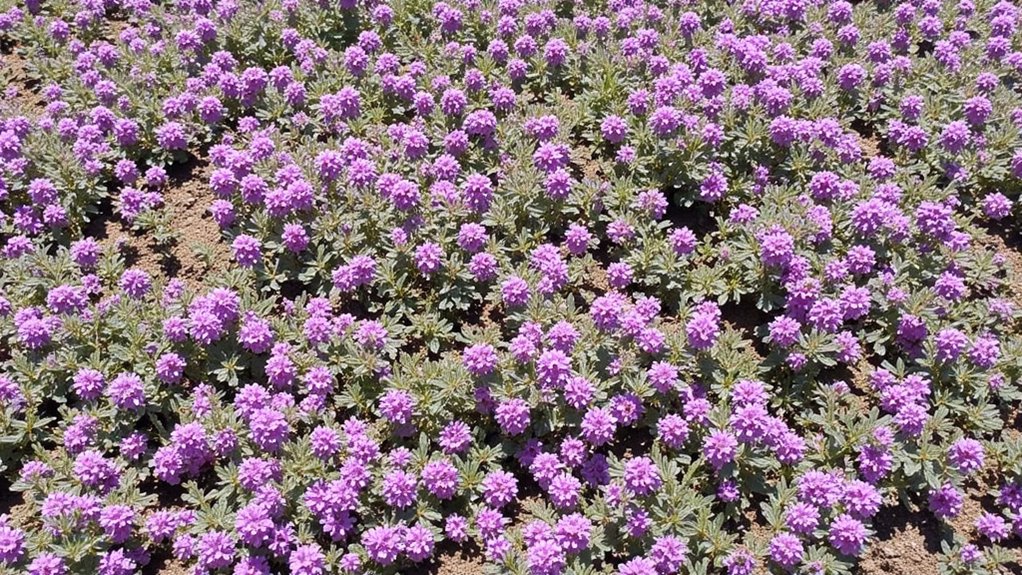
When you’re seeking hardy ground cover that flourishes in intense sunlight, trailing verbena (Verbena tenuisecta) delivers stunning results. This low-maintenance perennial spreads up to 3 feet wide, creating a dense mat of finely-cut foliage topped with clusters of purple, pink, or white flowers.
You’ll find verbena thrives in zones 6-10, requiring minimal water once established. Plant it 12-18 inches apart in well-draining soil, and you’ll see it fill empty spaces within one growing season. The plant’s drought tolerance makes it perfect for rock gardens and slopes.
During peak bloom from late spring through fall, you can expect continuous color that attracts butterflies and hums with pollinator activity. Simply trim back spent blooms to encourage fresh flowers, and cut it back by one-third in early spring.
